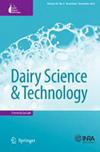Seasonal Study of Aflatoxin M1 Contamination in Cow Milk on the Retail Dairy Market in Gorgan, Iran
Q2 Agricultural and Biological Sciences
引用次数: 0
Abstract
Milk and milk products are the main nutritional foods for all age groups, especially for infants and children. Milk may be dangerous to consume due to the presence of a harmful substance called Aflatoxin M1 (AFM1). The objective of this study was to assess the levels of AFM1 in milk, particularly those that exceed the standards set by the European Union (50 ng/L), the Food and Drug Administration (500 ng/L), and the Iranian National Standards Organization (100 ng/L). The study included one hundred and eighty samples of raw cow’s milk from various retail dairy markets in Gorgan, with 45 samples collected during each season. The level of Aflatoxin M1 in the samples was measured using the enzyme-linked immunosorbent assay (ELISA) technique. AFM1 was detected in 139 (72.2%) raw cow milk samples with a range of 3.5–357 ng/L. All of the samples collected had Aflatoxin M1 concentration levels that were below the maximum limit of 500 ng/L set by the FDA. However, 41 samples (22.7%) exceeded the EU’s limit of 50 ng/L, and 26 samples (14.4%) exceeded the INSO’s limit of 100 ng/L for Aflatoxin M1 in raw cow’s milk. The lowest and highest AFM1 levels of contamination were detected in the summer and winter seasons, which constituted 32 (71.1%) and 38 (84.4%) samples, respectively. The consumption of raw cow milk can lead to health risks for individuals from various age groups because regulatory limits are not being followed.伊朗戈尔根零售乳制品市场牛奶中黄曲霉毒素M1污染的季节性研究
牛奶和奶制品是所有年龄组的主要营养食品,尤其是婴儿和儿童。牛奶中含有一种叫做黄曲霉毒素M1 (AFM1)的有害物质,饮用牛奶可能是危险的。本研究的目的是评估牛奶中AFM1的水平,特别是那些超过欧盟(50纳克/升)、美国食品和药物管理局(500纳克/升)和伊朗国家标准组织(100纳克/升)设定的标准的牛奶。该研究包括来自戈尔根各个零售乳制品市场的180个生牛奶样本,每个季节收集45个样本。采用酶联免疫吸附试验(ELISA)技术测定样品中黄曲霉毒素M1的水平。139份(72.2%)原料牛奶中检出AFM1,检测范围为3.5 ~ 357 ng/L。所有收集的样本中黄曲霉毒素M1的浓度水平均低于FDA规定的500ng /L的最大限值。然而,41个样品(22.7%)超过了欧盟规定的50 ng/L, 26个样品(14.4%)超过了INSO规定的100 ng/L的生牛奶黄曲霉毒素M1限量。AFM1污染水平最低和最高的季节为夏季和冬季,分别为32份(71.1%)和38份(84.4%)。由于没有遵守监管限制,食用生牛奶可能会给不同年龄组的人带来健康风险。
本文章由计算机程序翻译,如有差异,请以英文原文为准。
求助全文
约1分钟内获得全文
求助全文
来源期刊

Dairy Science & Technology
农林科学-食品科技
CiteScore
2.30
自引率
0.00%
发文量
0
审稿时长
2 months
期刊介绍:
Information not localized
 求助内容:
求助内容: 应助结果提醒方式:
应助结果提醒方式:


